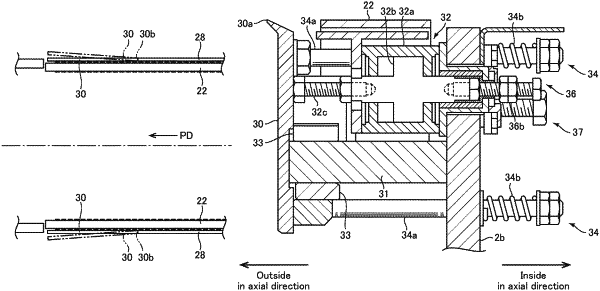| CPC B31B 50/62 (2017.08) [B31B 50/262 (2017.08); B31B 2100/00 (2017.08)] | 12 Claims |

|
1. A folder-gluer for folding a corrugated paperboard sheet having first to fourth panels and a joint flap connected in a line through a respective connection region, the folder-gluer configured to fold each of the first panel and the fourth panel along the connection regions and glue the folded first and fourth panels together through the joint flap, the folder-gluer comprising:
a conveyance device configured to convey the corrugated paperboard sheet in a conveyance direction;
a pair of first bending members which extend in the conveyance direction, wherein the pair of first bending members come into contact, respectively, with outside surfaces of the first and fourth panels of the corrugated paperboard sheet so as to bend the first and fourth panels from 0 degree to about 90 degrees while the corrugated paperboard sheet is conveyed by the conveyance device;
a pair of second bending members which extend in the conveyance direction between the pair of first bending members, wherein the pair of second bending members comprise a pair of folding edges configured to engage, respectively, with a crease line, or a vicinity thereof, formed in a reverse surface of the first panel and a crease line, or a vicinity thereof, formed in a reverse surface of the fourth panel to further bend the first and fourth panels, while the corrugated paperboard sheet is conveyed by the conveyance device, in cooperation with the pair of first bending members;
a pair of push-out devices configured to apply a push-out force to push the pair of second bending members away from each other transversely to the conveyance direction, wherein engagement of the pair of second bending members with the corrugated paperboard sheet effects a resistance force that pushes the pair of second bending members toward each other transversely against the push-out force, the resistance force being effected to increase, as the corrugated paperboard sheet advances through the pair of second bending members,
wherein the push-out device is further configured to:
(1) push the pair of second bending members away from each other along a first transversal distance therebetween, before the corrugated paperboard sheet arrives to engage with the folding edges of the pair of second bending members;
(2) responsive to the resistance force progressively increasing as the corrugated paperboard sheet advances through the pair of second bending members, push the pair of second bending members away from each other along a transversal distance therebetween progressively narrowing from the first transversal distance to prevent a tail end of the corrugated paperboard sheet from being extended transversely by the pair of second bending members no more than a transversal length of a leading end of the corrugated paperboard sheet; and
(3) push the pair of second bending members away from each other along the first transversal distance therebetween, after the corrugated paperboard sheet leaves the folding edges of the pair of second bending members and before a next corrugated paperboard sheet arrives to engage with the folding edges of the pair of second bending members.
|